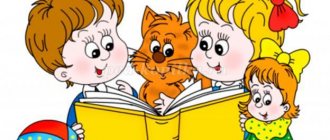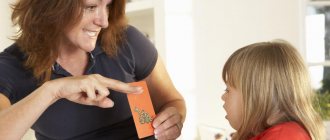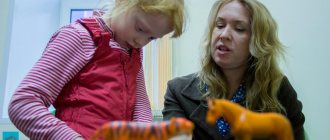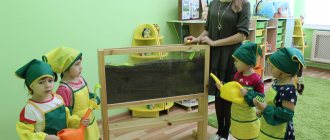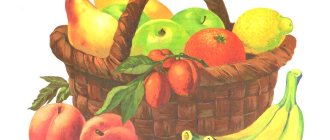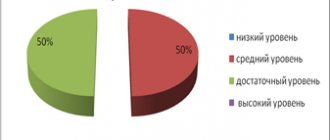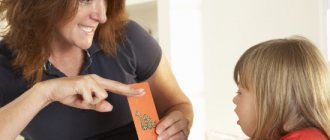What is the grammatical structure of speech
The grammatical structure of speech is the correct construction of speech (texts, sentences, dialogues).
The formation of grammatical structure occurs gradually. At first, children do not use prepositions in their speech, they may confuse the gender of the noun and place emphasis incorrectly. In the process of ontogenesis and normal speech development, vocabulary is enriched, new knowledge is acquired about the world around us, and sentences take on the correct form.
Therefore, teachers of preschool educational institutions are faced with the task of improving the grammatical structure of speech. More precisely, to help children understand the morphology, syntax and word formation of their native language.
How to form a grammatical structure of speech in preschoolers
The formation of the grammatical structure of speech in preschoolers is carried out according to several tasks:
- Formation of sentence structure. This task can be easily implemented based on the plots of various fairy tales. First, the teacher offers a fairy tale, and then the children try to compose a short retelling with the help of the teacher. The visual element of the work is also used - making sentences based on the plot depicted in the picture.
- Development of word formation. Word formation is a component of the grammatical aspect of speech that causes the greatest difficulties among preschoolers. Didactic games prove good effectiveness in this area. For example, exercise “Pets”. Children are invited to play and tell the composition of a family of domestic animals, what the cubs are called, and how they are useful in the household. Interesting tasks for this stage are those where you need to name a part or element of the whole.
- Development of coherent speech. In this task, the main activity is a role-playing game. Children need communication and building dialogue relationships. In such activities, children independently learn new techniques and means of communication.
Note! Thus, for the qualitative development of the grammatical structure of speech in children, communication with adults and peers is necessary. With the constant interaction of children with each other, non-forced and gentle development occurs.
Article:
Good speech is the most important condition for the comprehensive development of children. The richer and more correct a child’s speech, the easier it is for him to express his thoughts, the wider his opportunities for understanding the surrounding reality, the more meaningful and fulfilling his relationships with peers and adults, the more active his mental development is. The child’s communication with others is formed gradually: it includes understanding speech and its active use, taking into account the correct grammatical and phonetic format. At different age stages, the requirements for children's speech are different. So, at a young age, children should be able to repeat after the teacher a short story (based on a toy, a picture, a series of pictures, use sentences with homogeneous members, agree words in gender, number, case; in middle age - independently compose short stories, retell simple texts, consciously use words with a general meaning. At an older age - freely construct simple and complex sentences in structure and form them grammatically correctly, use constructions with direct and indirect speech, talk about an object, a picture, using a ready-made plan, and also compose them independently. But, Unfortunately, at present, many children experience difficulties in forming their own speech statements.The main difficulties manifest themselves in detailed answers to complex questions, children cannot consistently, competently and logically express their own opinions, reproduce the content of texts, they experience difficulties in composing stories. Therefore, the problem of forming the lexical and grammatical structure of speech is one of the most pressing problems. Authors such as T. B. Filicheva, T. V. Tumanova, T. A. Tkachenko paid special attention to the need to form lexical and grammatical structures in children. Work on the development of the lexical and grammatical structure of speech is carried out in 3 areas: accumulation of vocabulary, formation of a phrase and its inclusion in coherent speech. Let us dwell in more detail on the key points - the formation of a phrase and its inclusion in coherent speech. The content of vocabulary work is based on the gradual expansion, deepening and generalization of children’s knowledge about the objective world. As a result, children accumulate a significant amount of knowledge and a corresponding vocabulary, which ensures free communication in a broad sense (communication with adults and peers, understanding of literary works, television and radio programs, etc.). This dictionary is characterized by a variety of topics; all parts of speech are represented in it, which makes it possible to make a child’s speech at the end of preschool childhood meaningful, quite accurate and expressive. A very important point for the formation of phrases in children and the development of coherent speech is the familiarization of children with elementary forms of word formation. Work aimed at the formation of word formation occurs sequentially and in parallel and begins with nouns. First, children learn to form nouns using diminutive suffixes, the suffix - prostrate - with the meaning of container, they learn to form nouns denoting the names of young animals and birds; professions. In parallel, work is underway on the formation of adjectives (possessive, qualitative, relative). As well as verbs (reflexives, prefixes, perfect and imperfect forms) and a selection of related words. Exercises in independent formation of forms of nouns, adjectives and verbs are carried out on a variety of thematic material. The formation of inflection in preschoolers begins with exercises in distinguishing and comparing word forms. Children listen to the endings of nouns, singular and plural verbs, and to changes in case endings of the same word. Inflection skills are first reinforced in word combinations; then in sentences, then in connected speech. All work on the practical acquisition of the lexical and grammatical structure of the language is fundamental for the formation of different types of sentences. In order for children to be able to correctly construct and use simple sentences in their speech, it is important that all words are understandable to them. It is necessary to monitor the order of words in the sentence (if necessary, correct with the help of questions, the correct use of the appropriate form of the verb, its agreement in person and number with the noun. Children are encouraged to independently select homogeneous subjects, predicates, objects, etc. The basis for organization children's speech practice consists of practical actions with objects, active observations of life phenomena. By making up sentences to describe various actions based on the content of the picture, etc., children learn to talk coherently about what they saw. Gradually, such messages are combined into a short story. An effective means of forming vocabulary The grammatical structure of children's speech are games and exercises used in classes, in various types of activities, in routine moments. Parents provide significant assistance in the formation of lexical and grammatical structures. Joint work with parents is an integral part of the complex process of speech development. To improve the competence of parents, open classes, consultation conversations, training workshops and other types of work are held. Active and conscious assistance from parents significantly reduces the time required to improve children’s speech and produces positive results. Thus, by school age, children have mastered basically the entire complex system of practical grammar. Games for the development of the lexical and grammatical structure of speech “Call it affectionately” Valya-Valechka, Vasya, Sonya, Sasha, Dasha, Ira, Luda, Katya, Anya, Zina, Raya, Sima, Seryozha, Misha, Kostya, Dima, Natasha, Vera “ Show and name “head-head, forehead, ears, back of the head, lips, cheeks, eyes, eyebrows, eyelashes, neck, nose, tongue. "One and many." You name one object, but the child names many. Cucumber – cucumbers, eggplant -. radish -. tomato -. zucchini -. radish -. bob -. pumpkin -. squash -. “Count” Count vegetables to three according to the pattern: one tomato, two tomatoes, three tomatoes. One cucumber... One radish... One eggplant... One carrot... One zucchini... One turnip... One bean... One radish... “Yes - no.” The child pronounces the second part of the phrase with the words: “I don’t have it.” — I have fresh cabbage. — I don’t have fresh cabbage. Red tomato, green cucumber, blue eggplant, ripe bananas, sour lemons, sweet apple, bitter radish. “Which” Choose as many definitions as possible for each subject. Draw it in your notebook. Tomato – red, round, tasty, juicy. Banana, radish, onion, grapes, lemon, orange, turnip, apple. “Big-small” Teach children to correctly name small objects. You call a large object, but the child calls it small. Table-table. Bun -. Chair -. Cup -. Napkin -. Plate -. Cucumber -. Candy -. Sofa -. Shelf -. Knife -. Mug -. “Change the word” Complete the sentences by changing the word. There is one (tomato) in the basket. There are a lot of (trees) growing in the forest. There are few (animal) in the zoo. I have fewer (berries than Vova. Petya collected the same amount of (mushrooms as Sveta. “Pick up a word.” Choose a few nouns for the adjectives. Red cars, chairs, saucers. Blue... Warm... Metal... Knitted... Woolen... Plastic... Nouns must be of all three genders. “Big-small.” Hat - cap, jacket -..., skirt, suit, trousers, stockings, shoes, dress, coat, socks. “Say the word.” The car is in the garage... (drives). The boy from school... (comes out). The driver to the car... (approaches). The girl from the mountain... (moves down). The old lady across the street... (crosses). The girl through the puddle... (jumps over). The bird from the cage... (flies out). “Change.” word"He is sitting on the sofa. - They are sitting on the sofa. He runs along the path... He sings a song... He draws the sun... He goes home... He chops wood... "Whose?" A dog's tail is a dog's tail. Cow's milk is cow's milk. Lion's mane... Tiger's teeth... Horse's hooves... Rabbit's fur... Moose's horns... Cat's whiskers... Hare's tracks... Form possessive adjectives according to the model. Squirrel coat - squirrel coat. Mink collar... Fox hat... Sable cape... Camel wool blanket... Rabbit down hat... Insert appropriate words (adjectives). The sun is round like a ball. Hands like ice... A knife like a razor... A highway like an arrow... Snow like fluff... Grass like an emerald... “Praise” each picture, pick up as many words and definitions as possible. For example: Mittens - new, beautiful, expensive, red, comfortable, woolen, knitted, warm. Tell me from the example what kind of dishes it is. Made of glass - glass. From metal... From clay... From wood... From crystal... From silver... From plastic.... Give complete answers to the questions. What does a janitor use to sweep the street? How does the nurse give the injection? How does a hairdresser comb your hair? How does a chef cut carrots? What does a gardener use to loosen the soil? What does a painter use to paint walls? What does a carpenter use to plan boards? Count objects to ten, correctly matching numerals with nouns. One ball, two balls, three balls, four balls, five balls, six balls, seven balls, eight balls, nine balls, ten balls. Bucket, matryoshka, tree, house, window, fish, tractor. Change according to the sample: White - little white. Warm. Old. Sour. Easy. Clean. Kind. Thick. Sweet. Thin. Narrow. Soft. D/game “Hide and Seek” Purpose: to use spatial prepositions in speech: in, on, under, about, in front. Material: toys, objects behind which the toy can be hidden. Children close their eyes, the teacher hides the toy, opening his eyes, the child says where the toy is hiding, using prepositions. Options: game “Shop” The toy is sold to someone who indicates exactly where it is; the game “Putting everything in its place” (after wet cleaning in the play corner); construction games. D/u “Athletes” Purpose: to teach how to form a noun using suffixes. • An athlete who goes skiing -... (skier) • An athlete who goes skiing - (skier) Vocabulary material: runner-runner, gymnast-gymnast, swimmer-swimmer, football player-soccer player, etc. D/u “Tell who ? Goal: form complex words by combining two stems. Vocabulary material: A fisherman catches fish; breeds bees -... beekeeper; It flies itself -... an airplane; the forest is cut by the... lumberjack, the water is carried by... the water carrier; a lunar rover walks on the moon; cooks porridge -... cook; the barn carries -...a grain truck; meat chops -... meat chopper; etc. D/i “Who has what kind of mother” The goal is to teach children to form nouns using suffixes: -its, -ikh. Vocabulary material: Lioness, tigress, fox, she-bear, camel, hare, deer, hedgehog. Material: pictures of animals. D/i “Name your profession” Purpose: to form a noun using suffixes: -schik, -tel, -ist. • Repairs watches -... watchmaker • Raises children -... educator • Plays piano -... pianist Vocabulary material: crane operator, bricklayer, glazier, builder, teacher, driver, bulldozer driver, tractor driver, machinist D/i “Name the car in one word” Purpose: Exercise children in the formation of complex words. • A machine that peels potatoes -... (potato peeler) • A machine that cuts vegetables -... (vegetable cutter) Vocabulary material: coffee maker, coffee grinder, juicer, vacuum cleaner, floor polisher, concrete mixer, meat grinder D/u “say in one word” Purpose: to exercise in the formation of complex words • Long ear -… long-eared. • Blonde hair -... fair-haired Vocabulary material: short-tailed, blue-eyed, long-legged, long-armed, red-tailed, hardworking, fast-moving, black-browed. . D/u “What can you travel with?” Purpose: to practice the formation of nouns in the prepositional case. • What can you use to travel by air? (by plane) • And by water? Vocabulary material: on a train, ship, sailboat, skis, sleds, dogs, deer, car, camels, etc. D/game “what’s missing?” Purpose: to form genitive plural forms. nouns 8-9 pictures are displayed on the typesetting canvas. After the children name the objects depicted, the teacher asks them to close their eyes and hides one picture. -What happened? - There are no trees. (houses, etc.) . D/u “call it affectionately” Purpose: to practice word formation using diminutive suffixes. Vocabulary material: 1. Hormone, water, book, leg. 2. Truck. carriage, parrot, mushroom. 3. Boots, apples, books, houses. D/i “Focus” Purpose: To form diminutive forms of a noun using the suffix – ts- Material: “Magic wand” - Tree (the teacher touches the child with a wand) - tree Vocabulary material: oil, dish, swamp, lard, window, blanket, body cookies, mirror, dress, chair, soap, etc. D/i “Let’s dress the doll in clothes of the same color” Purpose: to coordinate nouns, adjectives in gender and number. Vocabulary material: (blue, red) dress - blue, bow - blue, socks - blue, jacket - blue, pants - blue, coat - blue, hat - blue, scarf - blue, boots - blue. D/i “Guess who we’re talking about?” Goal: to learn to agree nouns with adjectives in number and gender. Material: pictures (kittens, mouse, squirrel, fox, bear, elephant, crocodile.) Option I: the teacher asks riddles - descriptions. Option II: Children make riddles on their own. Beautiful, red-haired, cunning-... Huge, kind-hearted gray-... D/i “Hide and Seek” (animals) Purpose: to practice the formation of genitive plural forms of nouns. Material: pairs of pictures Vocabulary material: hares, foxes, mice, bunnies, puppies, kittens, cows, wolves, lions, elephants, tigers, hares, horses, bears, mice, hedgehogs, deer, horses, dogs, sheep, goats, zebras. D/i “Hide and Seek” (birds) Purpose: to practice the formation of genitive plural forms of nouns. Material: pairs of pictures. Vocabulary material: ducklings, goslings, chickens, ostriches, pigeons, crows, starlings, turkey poults, geese, pigeons, swifts, rooks, cranes, bullfinches, starlings, turkeys, ostriches, sparrows, ducks, hens, crows, herons, jackdaws, tits , swallows. D/i “What’s missing?” (Dishes, clothes, food.) Purpose: to practice the formation of genitive plural forms of nouns. Material: pairs of pictures. Vocabulary material: spoons, mugs, cups, plates, forks, frying pans, teapots, glasses, knives, pots; T-shirts, shirts, tights, T-shirts, skirts, pants, scarves, socks, sweaters, fur coats, coats; cookies, jam, sweets, apples, pears, plums, nuts, tomatoes, tangerines, oranges, bread, chocolate, sugar. “Development of the grammatical structure of speech in children 3-4 years old with the help of didactic games” Reasons for initiating the project: it is very important to teach a child to understand the meanings of grammatical forms as early as possible (from 3-4 years old). In the process of mastering them, grammatical skills are acquired and the grammatical structure of speech is formed. A modern child should master the system of his native language by the age of 4.5-5 years. If the meaning of grammatical forms remains unclear to the child, he will also find it difficult to understand the thoughts expressed. A child who has not mastered the grammatical structure of his native language in practical speech before school experiences difficulties in mastering educational material at school. Mastering grammatically correct speech affects the child’s thinking. He begins to think more logically, consistently, generalize, distract from the specific, and correctly express his thoughts. In preschool age, a child needs to develop the habit of speaking grammatically correctly. K. D. Ushinsky emphasized the need to form the habit of correct conversational speech from a very early age. The goal of the project: development of the grammatical structure of speech of children 3–4 years old. Project objectives: 1. Increase the level of professional skills and competence. 2. Familiarize parents with the project and involve them in joint activities. 3. Develop a work program for the development of the grammatical structure of speech of children aged 3–4 years. Project result: the level of development of the grammatical structure of children's speech increased by 30%. Project success criteria: - The result corresponds to the goal. - The plan has been completed. - We met the deadlines. Project implementation period: September 2021 – May 2021 Project plan: Self-realization: 1. Display of open events (games, entertainment, holidays); 2. Report on the topic of self-education; 3. Speech at the final teachers' meeting. Preparatory stage: 1. Study methodological and fiction literature on this topic: A. K. Bondarenko “Word games in kindergarten”; A. K. Bondarenko “Didactic games in kindergarten”; T. S. Shvaiko “Games and game exercises for speech development” and another. 2. Draw up a plan for the implementation of the main stage of the project. Main stage: Working with children: 1. Monitor children; 2. Replenish the subject-spatial environment; 3. Create a card index of didactic games for the development of the grammatical structure of speech of children 3–4 years old; - help children practically master the morphological system of their native language (changes in gender, numbers, cases, persons); — help children master the syntactic side: teach the correct agreement of words in a sentence, constructing different types of sentences and combining them in a coherent text. 4. Make presentations “Make a proposal based on the pictures”, “Big - small”, for the games “I see...” (singular and plural, “Guests”, “Guess whose things these are?”, “Who needs what? ". Work with parents: September 1. Questioning of parents" Speech of my child. Is he saying well? "2. To arrange an information stand for parents. October 1. Presentation at the parent meeting of the project" Development of the grammatical system of speech of children 3-4 years old using didactic games ”2. Folder-forward“ cognitive-speech development of preschoolers. ”November-December 1. Recommendations for parents to develop children's speech through finger games. 2. Folder-forward“ Games with children for the development of the grammatical structure of speech ”. January-January- February 1. Consultation “We teach the child to communicate.” 2. Recommendations to parents to activate the vocabulary of a child of 3-4 years old. March 1. Conducting a holiday March 8: congratulations to mothers and grandmothers, sing songs and read poems. April-May 1. Folder 1. Movement “Articulating Gymnastics for Children” 2. Presentation show on the topic “Verbal games for the development of the grammatical system of children” at the parent meeting. The final stage: - Processing of the results on the implementation of the project.
Word formation as a component of the grammatical aspect of speech
The word formation process, the formation of one word on the basis of another, is a rather complex process. It happens in several stages:
- first period (from 2.5 to 4 years). Words are formed accidentally, involuntarily;
- the second period (from 4 to 6 years), when there is an active accumulation of vocabulary and, at the same time, word production;
- the third period is the assimilation of rules and norms of speech.
Articulatory gymnastics for sounds “s, z, c”
Important! The active period of the word formation process is the age from 4 to 6 years and it is necessary not to miss this sensitive period. Underdevelopment of one of the stages leads to a decrease in the educational opportunities of the other. ONR is detected already in the early stages of development.
How grammatical speech structure is formed in the preschool period
Mastering grammatical structure is a complex mental process. The rules are gradually comprehended by children in living speech. The child does not yet know the relationships and connections of reality, and they are the basis for mastering grammar.
The first steps in learning the rules of your native language begin with the first words, but it is too early to talk about grammar at this time. After two years, the baby uses two-word sentences. Only by the age of three in the ontogenesis of some children can one observe the grammatical structure of speech in their short statements.
First, with the help of visually effective thinking, subject connections are learned, and this is followed by their formalization into words and sentences.
The child intuitively reproduces the connections and relationships that he observes around him. Since he wants to be understood, he focuses on the pronunciation standards of adults and step by step overcomes the stages of developing literate speech.
- Speech development in children 3-4 years old.
Until the age of 4, every word of a preschooler has a single interpretation that is understandable to him - he is talking about a specific object or situation. For example, it may require you to “turn on” an umbrella or smoke from a fire during a picnic.
In the fifth year of life, children discover word creation, which is directly related to word formation. They are amused by the rhyming words they come up with, like pear-fly, bunny-baby. They also assign new names to some things, often unexpected ones: sleds - lucky, paints - tags, etc.
A five-year-old preschooler gradually masters syntax and morphology. Learns to change words by gender and case. Uses singular and plural nouns and applies generalizations. Tries to observe the order of words in a sentence and the compatibility of words.
Mastering the grammatical norms of the native language affects the thinking of a preschooler. Logic appears in thoughts, consistency in their voicing, due to which coherent speech is formed. It should be noted that, no matter what language environment the child is in, the development of coherent speech in preschool children requires active thinking.
Development of the morphological aspect of speech
The morphological system is the kingdom of word forms and their speech properties. The grammatical structure of speech in preschoolers will be formed when they fully use all parts of speech. Morphology is the basis of the grammatical structure, which is responsible for changes and transformations of words in accordance with the laws of speech.
You will have to understand the number and gender of nouns, learn how to decline by case, use verbs in accordance with the tense form, and adjectives with their comparative degree.
Phonemic hearing, which is formed before the age of 2, helps a preschooler to immerse himself in the morphological system. First, the child focuses on the sound side of morphemes, listening to how elders speak, and then learns to pay attention to phonemic features. This is how the sound culture of speech is gradually formed.
Children begin to understand the singular and plural first. The most difficult thing for a preschooler to learn is the gender of nouns, because the analogy that the child easily applies does not work here.
It is difficult to understand the endings of nouns in different cases. The greatest difficulty is caused by the use of the genitive plural. Children do not understand why there are so many different variations of words: hands-hands, tables-tables, knives-knives. Therefore, in children's speech you can often hear: many “apples”, few “chairs”, five “plates”.
The prepositional case also causes problems. Having mastered the form in the house, in the room, children try to say “in the company”, “in the garden”. Errors in the use of verbs are common: “I get up”, “I cry” - by analogy with do, play; “run”, “stroke” instead of run and stroke.
Systematization allows us to identify typical errors in the speech of a preschooler:
- Distortion of nouns in the genitive (especially in the plural) and prepositional cases.
- Inability to determine the gender of a noun and correlate an adjective or verb with it (for example, the elephant fell, grandfather came, good Dasha).
- Inventing verbs based on already known analogies.
There are much more types of errors that children make in the process of forming grammatically correct speech. But every year the child gains speech experience, phonemic hearing helps to perceive grammatical forms, and many errors are eliminated without additional intervention.
Formation of word formation skills
The process of word formation is closely intertwined with morphology. A child's attempt at word creation helps the child understand that a new word can appear if the already familiar one is slightly changed.
Many word formations and inflections occur with the help of prefixes and suffixes. Of course, a preschooler does not know such structural concepts. But he intuitively identifies the root in a word and uses it to obtain a new one.
The first to be picked up are suffixes that lead to diminutive designations. Children actively use the words small, pretty, sleek, kind. Or nouns of another series - handkerchief, pot, kitten. At the same time, erroneous options often slip through: “spoon”, “stool”.
Methods of forming new words in preschool age are often based on the function that the concept denotes. So, instead of help, children say “help”, knocking is replaced with “knocking”.
It is especially difficult for a child to understand the definition of baby animals. Preschoolers try to use “horse” instead of foal, and “sheep” instead of lamb. Children cannot understand such concepts without the help of an adult.
It is important for parents to be attentive to what words are heard in the child’s speech and be sure to explain how to correctly name an object or being and correct erroneous forms of verbs and adjectives.
Mastering syntax by preschool children
Syntax is responsible for the order of words in sentences, their compatibility and agreement. It is the syntactic system that helps to form and express a thought. Only speech that is formed taking into account the rules of morphology and syntax is understandable to the interlocutor.
The child begins to construct the first sentences when his vocabulary has already accumulated about 50 words. Until the age of 4, he can formulate mostly simple sentences. Five-year-old children actively use conjunctions and make complex sentences (“I want to draw, but he won’t give me pencils!”, “We rode a train, then we bought ice cream and ate it”).
Complex sentences occupy a significant place in a child’s conversation: “We will eat candy when the guests arrive,” “Masha sat on a tree stump because her legs were tired.”
Syntactic errors manifest themselves in a violation of word order (“We’re going home, why?”), in the incorrect use of prepositions (“There is a hut at the edge of the forest”).
It is important to consider that syntax errors are more persistent. It is necessary to draw the preschooler's attention to the correct word order, explain the appropriateness of this or that preposition, and also show examples of new constructions so that the sentences are not of the same type.
Factors influencing the development of grammatical structure of speech
Among the factors that influence the development of speech in preschool children, educational psychologists identify social and genetic factors.
- Social factors. Family plays an important role in social factors. In a complete family, children do not experience a lack of communication and constantly practice their speech needs. If a child is raised by a single parent, the possibility of communication is significantly reduced. The number of children plays an important role. Communicating with brothers and sisters at home, children can realize their interests in active and role-playing games. But at the same time, as psychologists note, families with many children devote slightly less time to reading than families with one or two children.
An important point in the development of speech remains the material resource of the family and the level of education of the parents. Fathers and mothers of high socioeconomic status have children with larger vocabularies as a result of parents' own use of grammatically correct sentences. Such parents can allow children to receive more information about the world around them, enriching and organizing the subject environment. Moreover, in families where a warm atmosphere and mutual understanding prevail, the child’s vocabulary takes on a more emotional character.
By attending a preschool educational institution, preschoolers expand their range of communications and gain positive communication experiences.
- Genetic factors. The successful development of parents has a beneficial effect on the development of speech skills in children. The level of intellectual development and the ability to successfully learn is inherited. Children whose mothers and fathers did well in school and have higher education learn basic grammatical principles of speech a little faster.
Directions of speech development
The child’s speech and grammatical structure develop simultaneously in several directions: the ability to use speech in practice when communicating with people around him is formed, along with the development of speech, the mental component of the personality is rebuilt, the child begins to think and produce inner speech.
The literature on the research topic, combined with the research methods used, showed the degree of importance and significance of working with the speech development of preschool children. It is during this period of his life that a person most actively acquires spoken language.
It is now that the strongest foundations of his lexical, phonetic and grammatical aspects of speech are laid.
If you miss the opportunity to help a child at this age form literate speech and grammatical structure of speech, then in the future it will no longer be possible to create such a favorable environment for this. Right now, before the child goes to school, it is so necessary to help him become interested in the topic of his native language, feel a taste for it and acquire the desire to express his thoughts to other people through speech as accurately and competently as possible.
By the age when the time comes to move to the preparatory group, subject to pedagogical conditions, the child usually has a fairly wide vocabulary and copes well with the task of forming sentences with different constructions.
Also, children of this age usually cope well with the agreement of words in case, gender and number, easily work with word formation of verbs of different tenses, and pronounce sounds correctly.
Children of this age are also good at talking about what happened to them, retelling the contents of a book or a cartoon that is interesting to them.
Without difficulty, they are also given the task of describing some object or picture, talking about the phenomena of the surrounding world.
Studying the theory of the issue under study allowed us to conclude that the topic of the formation of the grammatical structure of speech, especially the development of the skill of working with morphology in the word formation of nouns, verbs and other parts of speech, is more than relevant.
